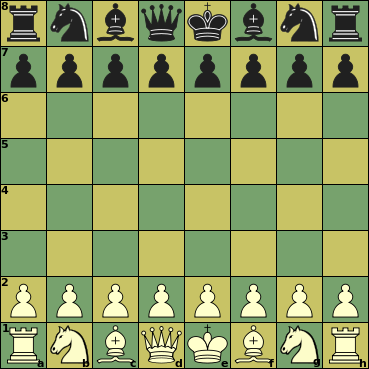Atomic Chess
 |
Initial setupe1, e8: King |
Moves at a Glance
Click on a piece below to see its moves
 |
 |
 |
 |
Sliding capture or non-capture, can be blocked on any square along the ray |
|||||||
 |
Unblockable leap (capture or non-capture) | ||||||||||
 |
Non-capture only | ||||||||||
 |
Capture only | ||||||||||
 |
 |
 |
 |
 |
 |
 |
|||||
 |
|||||||||||
:
:
:
:
| Piece | ID | value | Moves (Betza notation) | Remarks |
| King | K | - | K | Can castle with Rook, moving 2 steps towards it |
| Queen | Q | 9.5 | RB or Q | |
| Rook | R | 5 | R | |
| Bishop | B | 3.25 | B | Color-bound |
| Knight | N | 3.25 | N | |
| Pawn | P | 1 | mfWcfF | Promotes to Q, R, B, or N on reaching last rank |
Pawn peculiarities
- Pawns capture differently from how they move (straight move, diagonal capture).
- Pawns can move two squares straight ahead from their initial position, provided they are not blocked.
- On the move immediately after such a double push, they can be captured en passant by another Pawn, as if they had only moved 1 square ahead.
- Pawns promote to another (non-royal) piece of choice when they reach last rank.
Castling
A King that has not moved before can move two squares in the direction of a Rook that has not moved before, in which case that Rook is moved to the square the King skipped over. This is only allowed if all squares between King and Rook are empty, when the King is not in check on the square it came from, and would not be in check on any of the squares it skipped over.
General rules
- Captures destroy ('explode') both capturer and victim, and also destroy all non-Pawns adjacent to the capture square.
- The game is won by destroying the opponent's King.
- Destroying your own King is not allowed.
- Stalemate (no legal moves, but not in check) is a draw.
Differences with FIDE
Pieces explode on capture, destroying everything in the area including themselves. You win by destroyig the King rather than checkmating it; exposing your King to destruction is not forbidden (just stupid).
Strategy issues
Since any capturing piece destroys itself in the explosion, Kings can never capture.
A King taking shelter next to the opponent's King (which, after all, cannot capture) is immune to capture, as such a capture would destroy your opponent's King in the explosion. So many end-games (even KQK) can be drawn by tailing the opponnet's King!